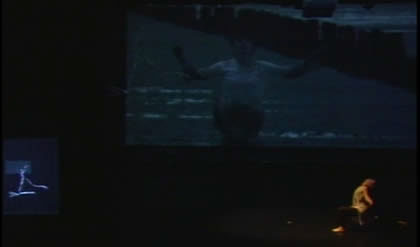
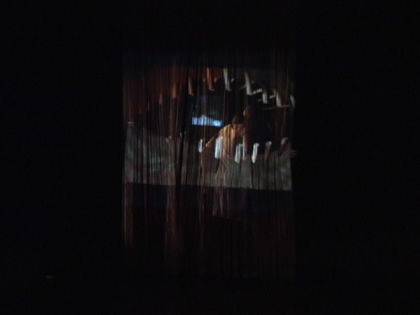
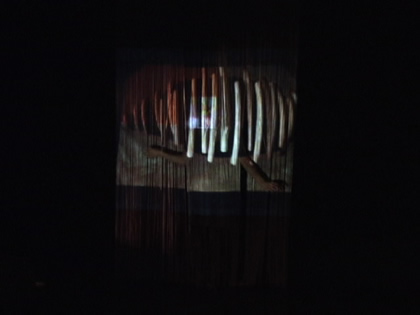
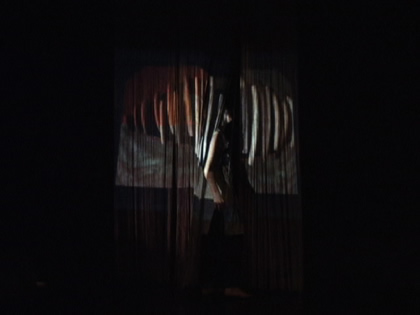
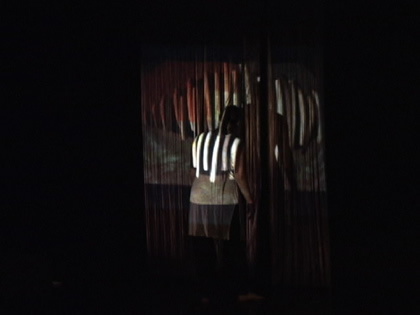
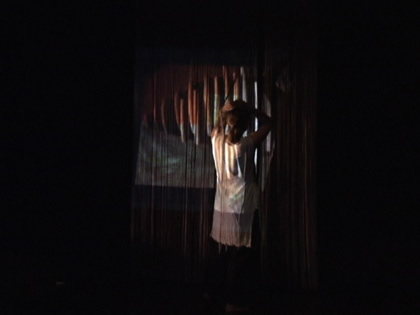
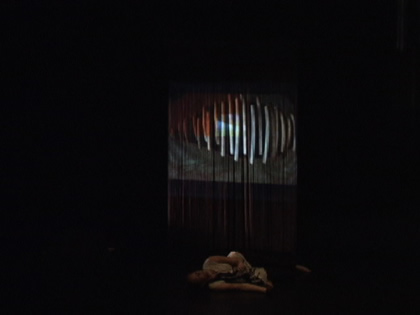
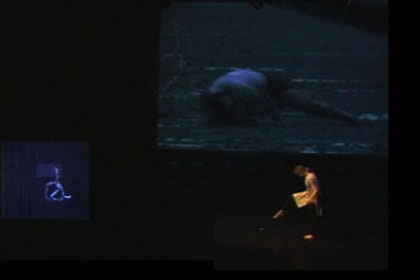
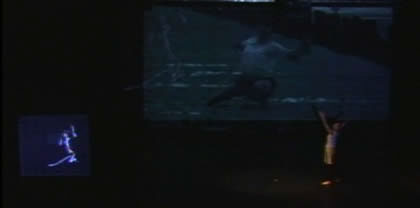
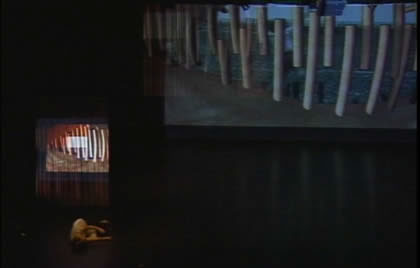
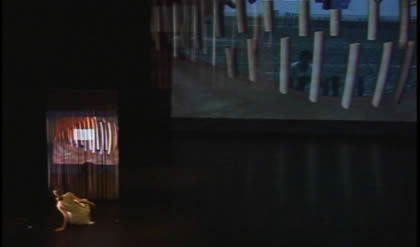

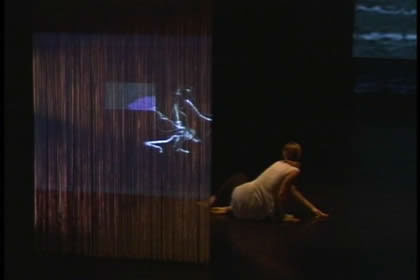

Arina Melkozernova has experimented with several interactive technologies that allow her to extend the power of her imagery in subsequent work. Arina’s recent collaborative project “The Eyes of the I’s” is an interactive multimedia performance with dance, video, animation and tracking system. It has been presented during the International Symposium of Interactive Art Design, January 5-7, 2005, Istanbul, Turkey. Her thesis-show “The Eyes of the I’s” based on collaborative project among School of Art, Dance Department and School of Music at Arizona State University has been successfully performed on January 27 – 30, 2005. The objective of the project is to produce the psychological condition of the displacement for the viewer. The condition of displacement appeals to Heidegger’s philosophical ideas. In “Letter on Humanism” Heidegger wrote: ‘Homelessness is coming to be the destiny of the world’ (Heidegger, 1947). The Second World War produced a condition of displacement as a new form of homelessness for 20 th century people. This “homeless” situation reinforced a growing feeling that modern man was, essentially and fundamentally, rootless. Besides war, an economic necessity is pushing people out of traditional family centered living patterns. We rely more heavily on virtual connections rather than on physical ones. The Internet or phone connections have become substitutes for physical contacts with people who are precious to us. A new global environment includes countless others for whom home is not a just a place or a language, but state of mind.
ARTIST'S STATEMENT
"The Eyes of the I's" by Arina Melkozernova in collaboration with Nahla Mattar and Casey Blake The structure of interactivity as a metaphor The goal of our collaborative work is to define the structure for interactive multi-media performance as a metaphor. The interactive performance serves as a vehicle for obtaining new aesthetic vision and artistic expression of time and space. According to pioneering VR artist Char Davies modern technology helps to perceive ourselves and the world around us freshly. The objective of the current project is to produce the emotional condition of the displacement for a viewer. This will integrate the viewer in his/her unity of time and place in order to absorb this experience by interaction with virtual and real environment. The condition of displacement appeals to Heidegger's philosophical definition of the destiny of the world. The philosopher, Heidegger wrote in his "Letter on Humanism": 'Homelessness is coming to be the destiny of the world' (Heidegger, 1947). The Second World War produced a condition of displacement as a new form of homelessness for 20th century people. According to Heidegger this "homeless" situation reinforced a growing feeling that modern man was, essentially and fundamentally, rootless. Besides war and economic necessity pushing people out of traditional family centered living patterns. Technology has played a part in creating generation of rootless people. Statistics show that the average American moves 5 times during his/her lifetime. The Internet or phone connections have become substitutes for physical contacts with people who are precious to us. We are learning to appreciate these virtual connections as necessary conditions of our life. We perceive ourselves as citizens of a new global environment which includes countless others for whom home is not a just a place or a language, but state of mind. Austrian psychologist Heinz Kohut came to the idea that people gather the information about ourselves by mirroring each other (Elson, 1987, p.3). The lack of relationships leads to the lack of identity, and to depersonalization. Jacques Lacan developed a philosophical idea of the Mirror-stage that reflects the imagery moment when the body becomes the image of itself, the moment of recognition of the Other (Lacan, 19XX; "Figuring Lacan", p.40). The state of Other is alienation from itself in the form of ideal and identity (Kristeva, 19XX). To recognize and accept the other side of yourself, you can overcome the fear of Other. A modern interactive technology is a medium through which we communicate with ourselves i.e. it is functioning as a mirror (Rokeby, 19XX). The medium not only reflects back, but also refracts what is given; what is returned is ourselves, transformed and processed. In the XXth century the artists tried to visualize these fundamental ideas through interactive performance, which engages with fundamental phenomena like time, space, and human body. The model of the interactive performance originates from performances of Dada and Surrealists. Jeffrey Shaw, a pioneer of the interactive art, linked genres of photography and video with virtual art. He had broken through the limits of the media developing a concept of immersion (Survey of Media Art, 2003). On the other hand, the interactive performance is rooted in the structure of Diaghilev ballets that was radically transformed by Merce Cunningham's innovations where the elements of the spectacle are independent of each other and often are brought together only in the very last stage of the creation (Catalog Diaghilev/Cunningnam, 1974). In this context, current experimental approaches developed by choreographers and visual artists in ISA project 'Motion e', a network-based, dynamic, collaborative and research-centric model for integrated research across disciplines and applications (http://ame2.asu.edu/projects/ motione/overview.html) are very interesting. Char Davies was motivated by "desire to push the technology and prove that it could indeed be used to express a different sensibility". (http://www.immersence.com/) The same kind of challenge united tree of us: visual artist, choreographer and composer to collaborate in this experimental project. The uniqueness of the project is in interactive experience and unusual perception of virtual and real environment. This is an attempt to visualize the hidden links between inner and outer space of the viewer. We are not interested in technological wizardry for its own sake but rather as a medium to express our personal sense of displacement, identity issues, and questions about otherness and self-reflection. We came to the use of technology for art from traditional training. Visual artist Arina Melkozernova has experience of collaboration with choreographers as well as with composers. The images she created worked in traditional way - only as background or only as foreground. She was desperate to find her way to forge the imagery into texture of performance and music. Arina used an interactive software MAX MSP that allows to manipulate and mix the prerecorded data from the visual vocabulary with real time video footage. The objectives of the project had been realized in an interactive performance arranged as a collaborative production of School of Art, School of Music and Dance Department at Arizona State University, USA. "The Eyes of the I's" is an interactive multimedia performance consisting of four parts. The first part "Home/Cocoon" reflects the idea of home as a quest for the place in real life. A pure choreographic approach in this part is used. The second part "Video solo" introduces the database of visuals. The objects of the database are video clips of short movies and 3D animation. Each clip has a symbolic code related to the major topics of the project: ideas of human displacement, rootlessness and self-recognition in the modern world. The third part "Boats" serves as a transition between a real and virtual 3D space, where dancers on the stage have a hidden connection to the images on the screen. Project uses a database of visuals that has been developed applying approaches of layering and mirroring. In the center of the collaborative projects is forging of visuals with the texture of the music and live dance performance. It was challenging to find a balance between the visual layers including the layer of live performers. A screen where the visuals are projected is not just a traditional background. In the project it is assigned a role of a mirror, which interacts with live performance of dancers or sounding music in a metaphorical way. Interactive structure is based on idea of reciprocal rooting. Interactive design reveals itself in blending of visual layers. In the beginning dancers control the blending of layers. This manipulation creates the visual association with images penetrating and rooted into each other. Each layer is the randomly selected movie clip from the database of visuals. A real time compositing and editing occurs on a big screen. The interactive structure provides the perfect timing for it. Performers bring the element of suspended time with choreographic rhythm. Circle completes in the finishing "dance solo" part. The virtual dancer from video clip controls the image of live performer projected in the real time. The interactive structure of the project is a metaphor of mutual influence of the real and virtual world, human inner and outer space, actual and spiritual connections of people. The message of the project is that people need each other as a mirror so that we can experience ourselves through each other. We are socially dependent on each other for actualization.
"The Eyes of the I's" by Arina Melkozernova in collaboration with Nahla Mattar and Casey Blake The structure of interactivity as a metaphor The goal of our collaborative work is to define the structure for interactive multi-media performance as a metaphor. The interactive performance serves as a vehicle for obtaining new aesthetic vision and artistic expression of time and space. According to pioneering VR artist Char Davies modern technology helps to perceive ourselves and the world around us freshly. The objective of the current project is to produce the emotional condition of the displacement for a viewer. This will integrate the viewer in his/her unity of time and place in order to absorb this experience by interaction with virtual and real environment. The condition of displacement appeals to Heidegger's philosophical definition of the destiny of the world. The philosopher, Heidegger wrote in his "Letter on Humanism": 'Homelessness is coming to be the destiny of the world' (Heidegger, 1947). The Second World War produced a condition of displacement as a new form of homelessness for 20th century people. According to Heidegger this "homeless" situation reinforced a growing feeling that modern man was, essentially and fundamentally, rootless. Besides war and economic necessity pushing people out of traditional family centered living patterns. Technology has played a part in creating generation of rootless people. Statistics show that the average American moves 5 times during his/her lifetime. The Internet or phone connections have become substitutes for physical contacts with people who are precious to us. We are learning to appreciate these virtual connections as necessary conditions of our life. We perceive ourselves as citizens of a new global environment which includes countless others for whom home is not a just a place or a language, but state of mind. Austrian psychologist Heinz Kohut came to the idea that people gather the information about ourselves by mirroring each other (Elson, 1987, p.3). The lack of relationships leads to the lack of identity, and to depersonalization. Jacques Lacan developed a philosophical idea of the Mirror-stage that reflects the imagery moment when the body becomes the image of itself, the moment of recognition of the Other (Lacan, 19XX; "Figuring Lacan", p.40). The state of Other is alienation from itself in the form of ideal and identity (Kristeva, 19XX). To recognize and accept the other side of yourself, you can overcome the fear of Other. A modern interactive technology is a medium through which we communicate with ourselves i.e. it is functioning as a mirror (Rokeby, 19XX). The medium not only reflects back, but also refracts what is given; what is returned is ourselves, transformed and processed. In the XXth century the artists tried to visualize these fundamental ideas through interactive performance, which engages with fundamental phenomena like time, space, and human body. The model of the interactive performance originates from performances of Dada and Surrealists. Jeffrey Shaw, a pioneer of the interactive art, linked genres of photography and video with virtual art. He had broken through the limits of the media developing a concept of immersion (Survey of Media Art, 2003). On the other hand, the interactive performance is rooted in the structure of Diaghilev ballets that was radically transformed by Merce Cunningham's innovations where the elements of the spectacle are independent of each other and often are brought together only in the very last stage of the creation (Catalog Diaghilev/Cunningnam, 1974). In this context, current experimental approaches developed by choreographers and visual artists in ISA project 'Motion e', a network-based, dynamic, collaborative and research-centric model for integrated research across disciplines and applications (http://ame2.asu.edu/projects/ motione/overview.html) are very interesting. Char Davies was motivated by "desire to push the technology and prove that it could indeed be used to express a different sensibility". (http://www.immersence.com/) The same kind of challenge united tree of us: visual artist, choreographer and composer to collaborate in this experimental project. The uniqueness of the project is in interactive experience and unusual perception of virtual and real environment. This is an attempt to visualize the hidden links between inner and outer space of the viewer. We are not interested in technological wizardry for its own sake but rather as a medium to express our personal sense of displacement, identity issues, and questions about otherness and self-reflection. We came to the use of technology for art from traditional training. Visual artist Arina Melkozernova has experience of collaboration with choreographers as well as with composers. The images she created worked in traditional way - only as background or only as foreground. She was desperate to find her way to forge the imagery into texture of performance and music. Arina used an interactive software MAX MSP that allows to manipulate and mix the prerecorded data from the visual vocabulary with real time video footage. The objectives of the project had been realized in an interactive performance arranged as a collaborative production of School of Art, School of Music and Dance Department at Arizona State University, USA. "The Eyes of the I's" is an interactive multimedia performance consisting of four parts. The first part "Home/Cocoon" reflects the idea of home as a quest for the place in real life. A pure choreographic approach in this part is used. The second part "Video solo" introduces the database of visuals. The objects of the database are video clips of short movies and 3D animation. Each clip has a symbolic code related to the major topics of the project: ideas of human displacement, rootlessness and self-recognition in the modern world. The third part "Boats" serves as a transition between a real and virtual 3D space, where dancers on the stage have a hidden connection to the images on the screen. Project uses a database of visuals that has been developed applying approaches of layering and mirroring. In the center of the collaborative projects is forging of visuals with the texture of the music and live dance performance. It was challenging to find a balance between the visual layers including the layer of live performers. A screen where the visuals are projected is not just a traditional background. In the project it is assigned a role of a mirror, which interacts with live performance of dancers or sounding music in a metaphorical way. Interactive structure is based on idea of reciprocal rooting. Interactive design reveals itself in blending of visual layers. In the beginning dancers control the blending of layers. This manipulation creates the visual association with images penetrating and rooted into each other. Each layer is the randomly selected movie clip from the database of visuals. A real time compositing and editing occurs on a big screen. The interactive structure provides the perfect timing for it. Performers bring the element of suspended time with choreographic rhythm. Circle completes in the finishing "dance solo" part. The virtual dancer from video clip controls the image of live performer projected in the real time. The interactive structure of the project is a metaphor of mutual influence of the real and virtual world, human inner and outer space, actual and spiritual connections of people. The message of the project is that people need each other as a mirror so that we can experience ourselves through each other. We are socially dependent on each other for actualization.



